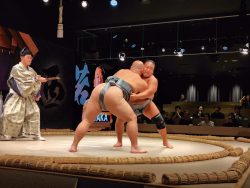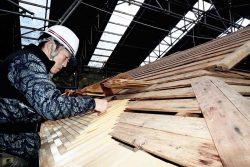
Indigo-dyed yukata cotton kimono and work clothes from the Meiji era (1868-1912) to the Showa era (1926-89) are on display at a special exhibition at the Bunka Gakuen Costume Museum in Shibuya Ward, Tokyo. Indigo dye was used to paint bamboo trees on the yukata on far left.
14:57 JST, December 15, 2020
Clothing and accessories are often interpreted as forms of cultural expressions. But they can also be hints as to where on Earth they come from. To experience both, I visited the Bunka Gakuen Costume Museum in Shibuya Ward, Tokyo, one of the few museums in Japan that specialize in clothing from around the world.
The museum holds four special exhibitions annually, but does not feature a permanent exhibition as light and air can damage fabrics left out in the open for extended periods of time. The current exhibition, titled “Sekai no Ai” (Indigo of the world), is on display through Dec. 18. It features indigo-dyed fabrics and garments from Japan and about 40 countries in Africa, Asia, Latin America and others.
Once inside the exhibition hall, a basic explanation on indigo dyeing is displayed, which involves the fermentation of plants yielding blue pigmentation. Such plants include Indo-ai, or indigo from India, and Ryukyu-ai, or Assam indigo. In Japan, where the word for indigo is “ai,” the tade-ai plant’s use as an indigo dye resource had become well established by the eighth century.
Indigo blue was favored by Samurai families as a hue fitting their ethos of respecting honesty and modesty. The dye was often used for their clothing, such as kamishimo suits. When cotton production blossomed in the Edo period (1603-1867), indigo dyeing also spread among the commoners. Indigo-blue kimono for workers became synonymous with indigo dyeing and so did the white cotton summer yukata kimono dyed with vivid indigo patterns. The bamboo motifs and colorful stripes added some playfulness that contrasted to the utilitarian workers uniform. Both styles are on display at the exhibition.
The exhibition’s non-Japanese garment section also features a rich variety of colors and designs.

A ceremonial robe from China’s Qing dynasty is displayed at the Bunka Gakuen Costume Museum in Shibuya Ward, Tokyo.
In China, textile techniques developed early. Indigo dyeing had been in use since before the days of Jesus Christ and the technique of adding indigo with red or yellow pigments was also developed to produce other colors such as purple or green. A ceremonial robe from the Qing dynasty is on display at the exhibition and is replete with embroidered dragons and other motifs.
To this day, there are some areas in southern China and Southeast Asia that still do indigo dyeing as a sacred practice.
From South Asia, a 1980s to 1990s Bangladeshi dark blue sari for women is on display at the exhibit. Such clothes from the region are worn by women in mourning. The indigo-dyed sari fabric is also indicative that the color is used for a wide range of cultural practices worldwide.
“What people wear tells us many things about them, such as their set of values and the social climate surrounding them,” said Kayoko Murakami, the museum’s curator. “This is true not only with indigo.”

Indigo-dyed threads are used for embroidering flowers on this French dress dated from around 1765 to 1780.
An elderly woman perusing the colorful exhibition caught my attention. She was wearing a checkered mask in beige, which was likely coordinated to go along with her coat.
Could this have been another example of the social climate manifesting itself in fashion?
I decided to listen to the voices of the exhibits once again.
Bunka Gakuen Costume Museum: 3-22-7 Yoyogi, Shibuya Ward, Tokyo
Related Tags
"Features" POPULAR ARTICLE
-

Students Recreate 19th-Century Bento Boxes Made for Ino Tadataka’s Survey Team in Hot Spring Town on Nakasendo Road
-

Santa Claus Delivers Christmas Presents to Penguins at Aquarium in Japan’s Nagasaki Prefecture
-

Sumo Restaurant in Tokyo Teaches Foreign Visitors About the Ancient Sport, with Bouts Between Retired Rikishi
-

Autonomous Passenger Ship Connects Mainland with Remote Island in Seto Inland Sea; World’s 1st Commercially Operated Autonomous Vessel
-

Osaka’s Sumiyoshi Taisha Shrine Bustles with New Year’s Visitors
JN ACCESS RANKING
-

As Chinese Tourists Shun Japan, Hotels and Stores Suffer
-

Osaka-Kansai Expo’s Economic Impact Estimated at ¥3.6 Trillion, Takes Actual Visitor Numbers into Account
-

Japan Govt Adopts Measures to Curb Mega Solar Power Plant Projects Amid Environmental Concerns
-

BOJ Gov. Ueda: Highly Likely Mechanism for Rising Wages, Prices Will Be Maintained
-

Economic Security Panels Debate Supply Chains, Rare Earths; Participants Emphasize Importance of Cooperation Among Allies

























